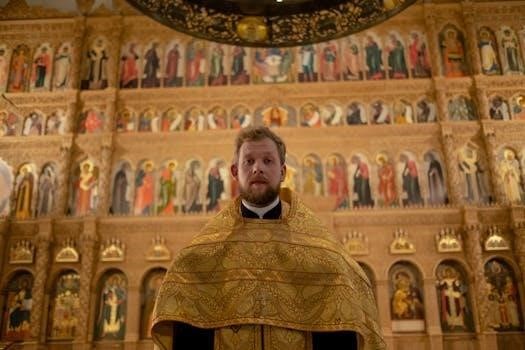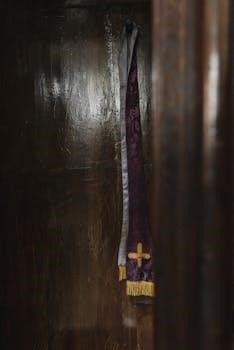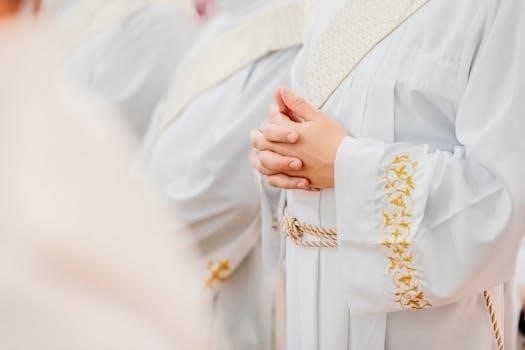The elaborate garments worn by the High Priest held profound significance. These vestments bestowed dignity and honor‚ revealing spiritual truths. Their design and materials symbolized the High Priest’s role as a representative before God.
Overview of the High Priest’s Role and Garments
The High Priest held the most sacred office in ancient Israel‚ representing the people before God. He interceded on their behalf and performed vital rituals‚ especially on the Day of Atonement. Exodus 28 details God’s commands for specific garments‚ bestowing dignity and honor upon Aaron and his sons. These garments included the tunic‚ robe‚ ephod‚ breastplate‚ turban‚ and sash‚ each meticulously crafted with specific materials and colors.
Beyond mere attire‚ these garments symbolized profound spiritual truths and the High Priest’s consecrated role. They reflected the beauty‚ glory‚ and holiness associated with God’s presence. The High Priest’s garments served as a constant reminder of his sacred duties and his representation of the entire nation of Israel before the Divine.
The High Priest’s position was transferred to his oldest son‚ down through the generations.
Significance of Exodus 28 in Understanding the Garments
Exodus 28 is paramount in understanding the High Priest’s garments‚ as it contains a detailed description of God’s specific commands to Moses. It outlines the materials‚ colors‚ and construction of each garment‚ emphasizing their sacred nature and purpose. God instructed that these garments were to bestow dignity and honor upon Aaron and his sons‚ setting them apart for their holy service.
The chapter reveals that the garments were not merely ceremonial attire‚ but tangible symbols representing the High Priest’s role as mediator between God and the people. Exodus 28 highlights the importance of precision and adherence to God’s instructions in creating these garments. This ensured they accurately reflected the divine attributes and the High Priest’s consecrated position.
The detailed instructions in Exodus 28 provide invaluable insight into the spiritual significance and symbolic meanings embedded within each element of the High Priest’s attire.

Specific Garments and Their Symbolic Meanings
Each garment worn by the High Priest possessed unique symbolic meaning. The ephod‚ breastplate‚ turban‚ and robe represented different aspects of his role and responsibilities before God and the people of Israel.
The Ephod⁚ Symbol of Burden and Privilege
The ephod‚ skillfully woven with gold‚ blue‚ purple‚ and scarlet threads‚ was a crucial garment. It symbolized both the burden and privilege of the High Priest. Worn over the shoulders‚ it was attached with onyx stones set in gold. These stones were engraved with the names of the sons of Israel‚ signifying the High Priest’s representative role before God for all the tribes.
The ephod served as a constant reminder of the weight of responsibility placed upon the High Priest. He bore the names of the people‚ interceding on their behalf and carrying their concerns before the Lord. At the same time‚ it represented the honor and unique access he had to God’s presence.
The intricate craftsmanship and precious materials reflected the sacredness of his office. It symbolized God’s presence and the High Priest’s role as a mediator between God and humanity‚ signifying a profound spiritual connection.
The Breastplate⁚ Representing the Tribes of Israel
The breastplate‚ a significant element of the High Priest’s attire‚ held immense symbolic value. Adorned with twelve precious stones‚ each representing one of the twelve tribes of Israel‚ it symbolized the High Priest’s role as a representative of the entire nation before God. This symbolized that the high priest represented the people before God;
Each stone‚ unique in its beauty and character‚ reflected the distinctiveness of each tribe. The arrangement of the stones upon the breastplate signified the unity of Israel under God’s covenant. The High Priest bore the names of the tribes upon his heart‚ demonstrating his care and concern for their well-being.
As the High Priest entered the Holy Place‚ he carried the weight of the nation’s hopes and prayers. The breastplate served as a constant reminder of his responsibility to intercede on their behalf and seek God’s favor for all of Israel‚ reflecting the idea of the high priest.
The Turban and Golden Plate⁚ Consecration to the Lord
The turban‚ crafted from fine linen‚ and the golden plate‚ affixed to its front‚ formed a powerful symbol of consecration and holiness. The golden plate‚ inscribed with the words “HOLY TO THE LORD‚” signified the High Priest’s complete devotion and separation for God’s service. This inscription signified the consecration of the priest to Gods service‚ marking him as set apart for holy duties.
The turban itself‚ encircling the head‚ represented the High Priest’s commitment to pure thoughts and intentions. By wearing the turban and golden plate‚ the High Priest publicly declared his dedication to upholding God’s law and performing his duties with utmost reverence.
This headwear symbolized the High Priest’s unique position as a mediator between God and the people. It served as a visual reminder of the sacredness of his office and the importance of maintaining holiness in all aspects of his life‚ Overall Symbolism The priestly garments collectively symbolized the beauty‚ glory‚ and the holiness that God expects from His children.

Materials and Colors⁚ Symbolism and Significance
The materials and colors used in the High Priest’s garments were not arbitrary. Each element held symbolic weight‚ representing aspects of God’s nature‚ purity‚ and the relationship between God and humanity.
Gold⁚ Symbolizing Purity and Holiness
Gold‚ a precious metal‚ was extensively used in the High Priest’s garments. It is a symbol of purity and holiness‚ reflecting the divine nature of God. The presence of gold signifies the precious and holy attributes associated with God’s glory and majesty.
Scriptural references highlight gold’s importance in sacred objects‚ such as the Ark of the Covenant and the golden lampstand. Its use underscores the sacredness and divine character of these items and‚ by extension‚ the High Priest who wore garments adorned with gold.
Gold represents purity of heart and symbolizes the High Priest’s dedication to serving God with a pure conscience. The radiant gleam of gold evokes the splendor of God’s presence‚ reflecting His unblemished nature and absolute holiness. It serves as a constant reminder of the divine qualities the High Priest embodies in his sacred role‚ highlighting the expectation of holiness God desires from His children.
Linen⁚ Representing Purity and Separation
Fine linen was another crucial material used in the High Priest’s garments. Linen represents purity and separation‚ symbolizing the High Priest’s need to be set apart for holy duties. The tunic‚ made of pure white linen‚ modestly covered the entire body‚ emphasizing modesty and holiness.
As a vegetable aspect of man‚ linen represents total sensuousness‚ highlighting the contrast between the physical and the spiritual. The High Priest‚ clothed in linen‚ demonstrates a separation from worldly desires‚ focusing on spiritual purity. Linen signifies a life dedicated to God.
The fine woven linen symbolizes Christ’s perfect righteousness‚ covering humanity in a state of purity. This garment suggests being set apart for God’s work‚ emphasizing the importance of maintaining a life free from sin. The High Priest’s linen garments serve as a visual representation of the need for spiritual cleansing and dedication to divine service‚ reflecting a life consecrated to God’s purpose.
Colors⁚ Symbolism and Meaning
The colors used in the High Priest’s garments held significant symbolic meaning. Blue‚ purple‚ and scarlet threads were interwoven with gold‚ each color carrying a specific message. These colors‚ also found in the sanctuary‚ enhanced the beauty and conveyed spiritual truths about the High Priest’s role and responsibilities.
Blue often represents heavenly grace and divine revelation‚ while purple symbolizes royalty and majesty‚ reflecting the High Priest’s elevated position. Scarlet‚ a vibrant red‚ signifies sacrifice and atonement‚ reminding of the need for cleansing from sin. The combination of these colors created a rich tapestry of meaning‚ illustrating the multi-faceted nature of the High Priest’s office.
These colors are connected to the gospel illustrated through salvation‚ woven throughout God’s Word. Unresolved trauma limits vision‚ but God has given us color for specific reasons. The priestly garments have a special message for you.

Typological Significance⁚ Christ as the Ultimate High Priest
The priestly garments foreshadowed Christ‚ our High Priest. Garment symbolism finds fulfillment in Christ’s sinless perfection. Christ entered the heavenly sanctuary‚ offering Himself as the perfect sacrifice‚ thus fulfilling the garments’ symbolic meaning.
Fulfillment of Garment Symbolism in Christ
From a typological perspective‚ the priestly garments foreshadowed Jesus Christ‚ our ultimate High Priest. In the New Testament‚ Christ is described as our High Priest‚ entering the heavenly sanctuary once for all‚ offering Himself as a perfect sacrifice. The garments’ symbolism finds its ultimate fulfillment in Christ’s sinless nature and atoning sacrifice.
The robe symbolizes righteousness conferred upon believers through Christ’s sacrifice‚ while the turban represents spiritual consecration in Christ. The ephod represents Christ’s divine and human natures. The finished work of grace completed by Jesus will never end.
The garments teach us the holiness God expects from His children. Christ’s priesthood is a transfiguration of the Levitical priesthood. He is the mediator‚ and His garments symbolize His glory. We recognize by faith the plan of God that has saved us. The priestly garments are a picture of the gospel‚ a symbol of God’s presence among His people‚ and a reminder of the burden of sin Christ bore for us.

The Garments in the Tabernacle and Temple Context
The garments were not mere items; they were sacred equipment. They appertained to the Mishkan (Tabernacle) and underscored the beauty and glory. The sanctuary’s colors mirrored those of the garments‚ adding to their significance.
Garments as Sacred Equipment of the Mishkan
The elaborate and meticulously crafted garments worn by the High Priest were far more than mere articles of clothing. They held a place of paramount importance within the Tabernacle (Mishkan) and later‚ the Temple. These vestments were regarded as sacred equipment‚ integral to the performance of priestly duties and the overall sanctity of the sanctuary.
The garments were not simply personal items belonging to the High Priest; rather‚ they were considered an essential part of the Mishkan’s furnishings and were treated with the utmost reverence. Their inclusion in the detailed instructions for the construction of the Mishkan‚ as well as in the account of their actual manufacture‚ underscores their significance as sacred objects.
The colors and materials used in the garments‚ such as gold‚ blue‚ purple‚ and scarlet‚ mirrored those used throughout the sanctuary‚ further emphasizing the connection between the High Priest‚ his garments‚ and the holiness of the Tabernacle. The garments served to visually represent the glory and beauty of God’s presence within the Mishkan‚ enhancing the worship experience for all who entered its sacred space.
